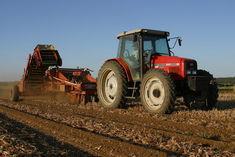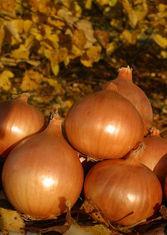

Like most vegetable crops across Europe this year, UK onions have suffered from the worst growing conditions known for many years. So says Jonathan Tole, chairman of British Onions.
An abnormally dry April, followed by heavy rain in May and June, and a below par July, have taken their toll. “Many crops have suffered damage from the deluge of rain and from sitting in water for many days or even weeks,” Tole tells FPJ. “The early sets now harvested have yielded very well, but there is much variation in quality both on skin finish and internal diseases. This issue is one not only found in the UK, but also in other European crops.”
Indeed, despite problems in the UK, sources say competing producers in the Netherlands and Germany are unlikely to steal a lead as key growers have suffered similar climatic anomalies.
The later crops, which are grown from seed and are normally supplied in the October to June period, have also endured miserable conditions. Tole says they have suffered from poor light levels, saturated soils and damaged root systems.
According to British Onions, the UK produces some 450,000 tonnes of onions on approximately 23,000 acres of land. The main growing regions are: Lincolnshire, East and West Anglia, Bedfordshire, Yorkshire and Kent.
British Onion’s grower members predict a mixed bag for the main crop this season. Sources say some fields will yield lower, poorer quality product, while others look very good. Given the difficult growing conditions this year, however, a number of producers are downbeat about crop yields.
“The regions that have been hit particularly hard by the weather could see a fall in yields of as much as 25 per cent,” says one source, who declined to be named. “But nationwide, I anticipate a drop of around 15 per cent.”
However, Tole says the main crop will be harvested in late September and the month’s weather will certainly play its part in the season ahead. Sources say the good weather this month should bring some respite but, at the current time, it is difficult to say to what extent.
Paul Davey, sales manager of South Humberside Onions (SHO), feels that quality issues will drive the market this season. “A two-tier system has already developed,” he tells FPJ. “The better quality crops should and will generate more revenue, but the poor crops will be at the mercy of the market.”
Parripak Foods, a leading vegetable preparation specialist, provides a wide range of onion products, including red onions, supasweet onions and shallots.
James Parrish, joint managing director of Parripak, agrees that yields of the set crop have been reasonable, but maincrop onions look more problematic and size and yield are likely to be issues. Furthermore, this year’s wet weather has caused problems with diseases. “We expect to see more internal problems such as neck rot,” Parrish says.
On top of this, the sector will also have to contend with storing onions. Quality could deteriorate towards the back end of the season, when Parrish predicts suppliers may have to look to the southern- hemisphere crop to fulfil demand.
“With all crops being under stress during the growing period, long-term quality must be questioned,” Tole agrees.
Davey anticipates that the critical months will be March through to May. “Only those growers who have complete confidence in their onions will be putting them into storage this season,” he adds.
Nevertheless, Tole claims that the UK enjoys some of the best storage and technical facilities in Europe, and domestic growers will have more chance of getting it right if there are problems compared to their European counterparts.
According to Tole, British Onions has continued to drive forward innovation through its R&D committee chaired by Alistair Findley. “This committee works hard to ensure Horticultural Development Council and member funds are correctly allocated and managed to keep the UK onion industry ahead of its counterparts around the world,” he says.
Tole has also called on all onion growers to work with British Onions to ensure sufficient funding to help continue marketing onions to consumers.
Although British Onions does not anticipate more consolidation among producers at packer level, the association says that with rising wheat prices verses high risk of onion growing, some growers will be considering their future in the industry.
Reports are already filtering in that some growers have left onions in the fields and significant losses will be sustained.
“It is therefore vital that, as an industry, growers, packers and retailers recognise the need for UK onions and provide sufficient support to maintain our grower base,” Tole says.
Earlier this month, British Onions joined forces with PR agency Sputnik Communications to launch a PR campaign to drive UK onion consumption.
“This campaign will focus mainly on some of the key health benefits of onions,” Tole says. “Consumers need to stop seeing the onion as an ingredient, but as a versatile and exciting vegetable that can improve meal enjoyment and bring a host of health benefits.”
Although there are not too many bright spots for onions this season, it is heartening to know that the vegetable itself still has an army of supporters. Supporters are keen to stress the health benefits of onions and claim that the vegetable contains a number of sulphur-rich compounds and beneficial antioxidants, including the flavonoid quercetin.
Researchers at Hokkaido Tokai University in Japan recently discovered an antioxidant in onions that binds with harmful toxins in the brain. It is hoped that these findings could prove valuable in the fight against ageing and neurodegenerative diseases, such as Alzheimer’s and Parkinson’s.
Education, research and development into the health benefits of onions must remain priorities, says the sector. “This will give people the confidence to invest in the industry,” Davey says.
Undoubtedly, the UK sector has a lot to contend with this season, but Tole is keen to emphasise that the UK onion industry is one of the most technically advanced in the world. “With state-of-the-art storage and good harvesting capacity, I believe when the weather does come right, we will be in a better position than some of our European counterparts,” he predicts.
Indeed, a number of those active in the industry are taking the long-term approach, and Parripak has invested in slicing equipment. This will improve the quality of slice and result in new products, Parrish tells FPJ.
When it comes to the processing sector, Parrish feels the UK sector needs to meet a number of criteria to compete with competition from Eastern Europe. He argues that, in theory, UK retailers want local British produce, grown to strict protocols. “This plays into the hands of home grown produce, however the UK needs to be able to supply year-round, stable priced and good-quality onions,” Parrish says.
KEY FACTS
More than 40 million tonnes of onions are produced each year.
More onions are consumed worldwide than any other vegetable.
China accounts for 26 per cent of global production.
Other major producers include the US, India and Russia.
The onion has a reputation as a potent aphrodisiac.
Onions contain the minerals: potassium, sodium, calcium, magnesium, iron, phosphorus, folic acid, selenium and zinc.
A wide variety of onions are produced, ranging from mild and cooking onions to supasweet, white and red.
Source: British Onions



